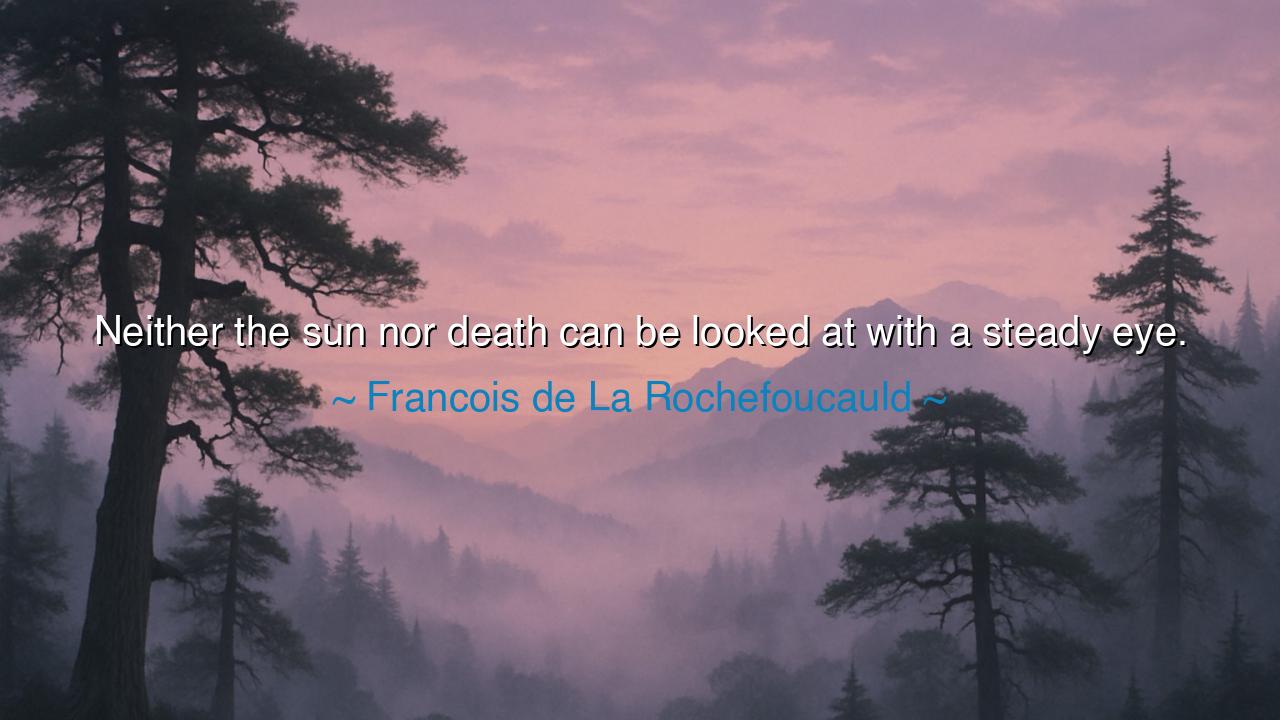
Neither the sun nor death can be looked at with a steady eye.






In the councils of elder wisdom, hear François de La Rochefoucauld lay down a quiet law: “Neither the sun nor death can be looked at with a steady eye.” The words arrive like an eclipse—slow, undeniable, and strangely cooling. He binds two immensities—the sun, which gives life, and death, which bounds it—and says that mortal sight cannot bear to stare either down. The line does not scold; it calibrates. It teaches that some truths must be received obliquely, with filters and rituals, lest we be blinded by their blaze.
The meaning is double. First, the sun: to gaze at it without veil is to injure the very organ that seeks to see. We honor it best by attending to its effects—shadows shortened at noon, crops ripening, warmth on the skin—rather than by a proud, direct stare. Second, death: to fix our eyes upon it without mercy or mediation is to risk a different blindness—despair, paralysis, a life spent circling the grave instead of walking the road. Thus the maxim is not cowardice; it is craft. Approach the sublime with instruments and customs; let reverence, story, and community be the smoked glass through which we look at the unbearable.
As to the origin, the sentence comes from La Rochefoucauld’s Maximes (Réflexions ou Sentences et Maximes Morales), first published in 1665 and revised through later editions. In French it reads, “Ni le soleil ni la mort ne se peuvent regarder fixement.” Like many of his aphorisms, it is spare, polished, and surgical: a courtier’s insight filed down to a blade. The seventeenth century loved such cut gems—truths you could carry in the pocket of the mind—and this one has endured because it names a limit we discover anew in each age.
To make the wisdom plain, recall a day of eclipse. A town gathers with pinhole cards and darkened lenses. Children, impatient, try to glance up with naked eyes; elders lay a gentle hand on their shoulders and turn them to the white circle where the sun’s bite appears safely in reverse. The lesson is older than astronomy: we see the greatest things best by indirection. Reverence is a way of looking. So too with death: we behold it truly when we attend to its penumbra—the confessions it summons, the reconciliations it hastens, the precision it gives to love—rather than attempting a bare stare that scorches hope.
History gives a sterner parable. A surgeon, brilliant and unsoftened, spent years priding himself on facing death “without illusions.” He spoke of odds and outcomes with a steel that cut his patients as sharply as his scalpel. Then illness visited his own house. He learned, painfully, that the unfiltered glare of mortality can bleach color out of the hours; he learned, too, the mercy of ritual: tea taken slowly, psalms murmured, the hand of a friend. He did not abandon truth; he learned to look at it through a human lens. Afterward he kept both the statistics and the songs.
La Rochefoucauld’s maxim is also a rebuke to vanity. We are tempted to think that courage equals unblinking inspection, that a “steady eye” proves strength. But bravery more often keeps company with humility: the sailor who navigates by the sun does not stare at it; the wise soul who orders a life by the knowledge of death does not idolize it. Instead, the sailor watches the sea and the instruments; the soul watches the calendar and the conscience. In both cases, the greatest light guides by reflection.
What, then, shall we take as rule? First, practice mediated attention. Toward the sun: keep sabbath hours outdoors, honor seasons, learn the names of light—dawn, zenith, gloaming—without scorning the shade. Toward death: keep short accounts, write the letters, order your house, and use the memento wisely—enough to sharpen love, not to dull it. Second, cultivate communities and rituals that let you look safely at immensities: funerals that tell the truth kindly; vigils that hold silence together; traditions that frame grief with meaning. Third, refuse both extremes—the bravado that stares and the denial that never looks. Walk the middle path of reverent clarity.
Carry the cadence like a pocket charm: sun, death, steady eye. Let it humble your urge to master what must be honored, and embolden you to honor what must be faced. For the ancients would say: the greatest lights are best approached with averted gaze and ready heart. Look not to conquer the blaze, but to live by it—so that when noon scorches or night gathers, you are neither blinded nor undone, but guided by the reflections that make the world bearable and bright.






AAdministratorAdministrator
Welcome, honored guests. Please leave a comment, we will respond soon